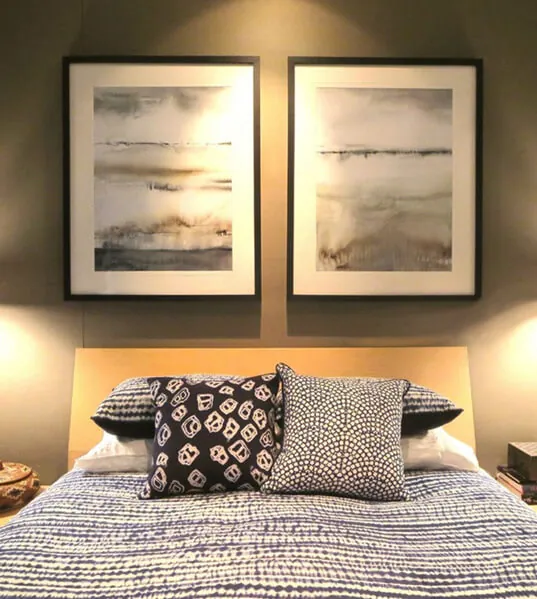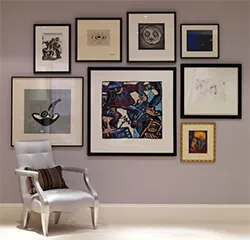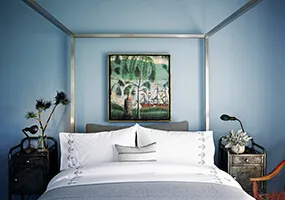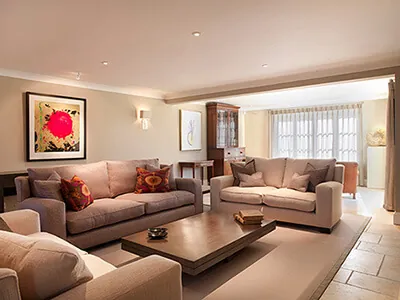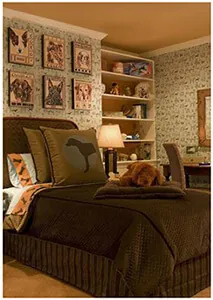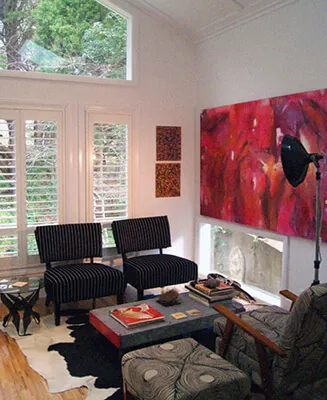By The Canvas Prints
A world where there are no rules for creatively displaying your artwork on the wall – This article will make you learn the most amazing secrets, tricks, tips and trends for displaying your artwork by leading experts from the industry. What, when, where and how, these experienced experts have all the answers to your challenging wall display questions.
Get creative today and make your walls more interesting with personal photographs, paintings, art and canvas prints. Apply these proven techniques to them and make your interior design more personal, meaningful and aesthetically pleasing.
Joe Human
"If you have children in the home, you’ll definitely have a lot of bright and colorful artwork to display (and that they will want to be shown off to guests), orient the art in symmetrical groupings and sophisticated frames for a custom & professional look."
Marilyne Estephan
via Splendour Interiors"I believe when hanging wall art it is quite important that the size of the art sits well in proportion with the wall. There are so many beautiful art pieces around and it is most important that you have something in your home that you love as it will be you admiring the works of art most of the time and offcourse your guests will too. Art is very personal and can be interpreted in so many different ways. As the saying goes a picture tells a thousand words. If hanging multiple art on the one wall I like to always go with odd numbers as it is more visually appealing to the eye. Also depending on the art piece a strong coloured background also helps to enhance the artwork."
Kerrie Kelly
via Kerrie Kelly"Don't be afraid to put a large statement piece of artwork even in a small space – you'll be surprised how it actually makes them seem more spacious."
Jess Preston
via Bow House"Putting art in to your home can be totally over thought. If you love a piece, don't think about it just buy it! Trust your instinct, it is the best way to buy. That way, if you totally loved it from the word go, you won't get bored of it.
The next trick is to remember that a piece of art, if framed, can look totally different in one from frame to another. Look at the core piece of art, decide which room to put it into and then either re-frame it to make it in order to make it work in the room or you can paint/adjust the frame to tie it into other items in the room.
Try to ensure that if you have a wooden frame, you match it to other woods in the room. If you have a silvered frame but brass door fixings and sockets in the room then you will need to change the frame to gilt, and vice versa."
Brett Mickan
via Brett Mickan Interior Design"In my opinion the biggest mistake made when hanging art is hanging it too high. Never think of art as something to fill a blank wall, think of it as an integral part of the entire space and should therefore have some visual connection to its environment. As a general rule, art should be at eye level from where it will be viewed. If this is from a seating area it will be at a seated eye height. Above a sofa, I usually like an approximate 10” spacing. In a contemporary open plan space use the hanging of the art to help define rooms within the room. Don’t hang your art on walls between areas, negative space is just as important as the art to make all areas feel cohesive and comfortable and make the art prominent."
Alex
via Casa Forma"You can use art to draw attention to a particular element in the room that you would like to highlight as the focus, such as a lovely marble mantle-piece or a wooden panelled contemporary wall."
Jacqueline Steinberg
via Eve Mode Design"I would say two things:
1) Make sure art size is proportional to wall it's on
2) Anchor art with furniture underneath so it's not just randomly "floating" on a wall"
Andrew
via Andrew Allen"If you are hanging a number of pieces it's worth employing a specialist picture hanger. Yes, they do exist! And never, ever buy art just because it matches your colour scheme."
Kathleen Walsh
via Kathleen Walsh Interiors"Fill a wall with multiple pieces of art of the same subject or type when you want to create an impact and reveal a story, but first want your eye to focus on something else in the room."
Emma & Alexandra
via Design Box London"Lining alcoves either side of a chimney breast with floor to ceiling mirror and hanging artwork on top of this creates a glamorous, multi-layered look whilst bouncing light around a room."
Anita
via Living in Space"Displaying art in your home can be a very personal exercise as certain styles are favoured by some and detested by others (which can become tricky when those two choices collide in one household!). Some pieces have sentimental value but may not fit in with your chosen interior style – these are all challenges that make sourcing or hanging art in client’s homes a challenge, but here are a few tips:
1. While symmetry may be the obvious choice when hanging art, asymmetry can prove equally interesting. If you don’t have a large enough piece to install on one wall, remember that negative space can be just as captivating – consider hanging your chosen piece of work closer to another feature in the room rather than right in the center.
2. Don’t be afraid to hang different styles together on one wall, in fact the more the better! The best way to collect items to display together is to keep them all within a similar tonal variance, and don’t forget a small amount of blank wall space around each frame to give every item a chance to ‘breathe’ amongst each other.
3. When considering hand-me-downs or sentimental pieces and how to introduce them into your new scheme, remember that a simple update can be obtained from merely replacing the frame. A good framer will be able to assist you in the choices out there and which ones would suit not only the art but the type of installation you’re after too. We are seeing a big trend toward aged heirlooms being displayed in contemporary box frames or glass and slim-panel framing."
Ramona Griffin
via Gnginteriordesign.com"My favorite art is something that is truly loved by the homeowner, whether it be vacation photographs or eclectic local art found in a specialty store. Displaying art where it is seen often by the owner means they can enjoy it more frequently. I love collages of small pieces grouped together or one large item in a place of honor like over the fireplace or sofa."
Lisa Melvin
via Lisa melvin design"Lighting is key when displaying your artwork at home , consider LED lighting available in many forms and colours , be very careful with the colour you choose , I find ‘daylight’ 6500k gives a neutral colour that will enhance not distort your artwork. "
Rowena Vaughan
via RJV Designs"Don’t put pictures too far up the wall. Pictures should be at eye height (obviously dependant on height of room, but a good rule of thumb). Pictures displayed in groups often look better than single pictures dotted around the room. Don’t be afraid to have blank walls. Good lighting makes better art – there are some great lights on the market now. Do be aware of the different tones of LED lights and the affect these will have on the colours in your pictures. When planning your room and electrical layout, always think about your art & Give sculptures ‘space’."
Robin Baron
via Robin Baron Design"Art is all about placement. The center of a piece should be at an average person's eye level... and it doesn't have to be hung like it's a museum! Be adventurous and layer your art. Place decorative objects on a console in front of the art and create depth and perspective. Here's a little secret... it brings more attention to the art itself."
Nicky Baruch
via NB Interiors"When it comes to displaying art in a home, as much consideration should be given to this as to furniture, fabrics and everything else. Sadly, many people think of art (if at all) as an afterthought, right at the end of a project, not realising that art can really "make or break" an otherwise beautiful scheme. Think about whether the art actually suits the room and decor, rather than as something to fill a space on the wall. A well-decorated and pleasing room is the sum of its parts and the quality of the art, framing and placement is an important component. Often, art is hung too high. Generally speaking the focal point of the art should be around eye level - lower than you think!
Although there aren't any "rules", strictly speaking, certain things should be considered. Art should be related to wall size and furniture size, so as to neither dominate or look insignificant. The colours should complement those in the room, or be linked in some way. Very bright colours should only be displayed in rooms which can handle them, so as not to look garish. There are many creative ways one can make artwork look great. Small pieces can be given a boost or new lease of life by framing in thick, interesting frames. Unifying disparate pieces by framing them in the same type of frame and hanging them together on a wall is a favourite. Incorporating vintage finds or found objects and framing them, to display with more conventional art is a great way of achieving an eclectic, yet curated look. Mix up the sizes, and above all, have fun experiment until you are happy with the result."
Drew McGukin
via Drew McGukin"For me, art in the home is about sharing a small glimpse into your "soul." The art is really what tells your story as a compliment to a beautifully designed space. I have three P's concerning art selection: Personal Purposeful Profound. In essence, your art needs to feel (key word) intentional. Art is a fantastic way to share something about yourself non-verbally. "
Joann
via Kandrac & Kole Interior Designs"The best advice I can give anyone for displaying artwork in your home is to have it be personal and meaningful. Galleries are my favorite way to display art by including not only photographs but items that bring back memories. As an example, create a gallery as a tribute to your grandmother. Include photos of her, young and old, framed favorite recipes (even if they are written on the back of envelopes and have stains on them), and if she wore pins, include those in a shadowbox. Have your art tell a story!"
Patrick Hamilton
via Ask Patrick"I think people make two mistakes when purchasing or displaying art: they are shy when it comes to scale, so they often end up with an odd "middle ground" size of art that seems to just float aimlessly on a large expanse of wall... although an intentionally undersized piece, if it's colorful or textural or graphic or dimensional enough, can also be really effective, and totally hold its own. The other is undermatting... I like a wider mat on most pieces than people most often consider. Find a good framer, and build a relationship with them. And if budget allows, and you have several pieces to hang, you're doing an architectural grid, or are putting together a gallery wall, invest in some professional picture-hanging services. My favorite one here in New York City is iLevel. Worth every penny! I really love displaying art on colored walls. My trick is to pull one of the lesser-prevalent colors from the image and relate the wall color to that tone. I'm also still super in love with shaped canvases!"
Jared Sherman
via Jared Sherman Epps Design"As important as the art itself, the scale of the art you put in a room will really determine how successful it is. One of my biggest pet peeves is a small piece of art on a large blank wall. You want to art to be a focal point—not look like a pimple on the wall. If you are doing one large piece you should hang it at eye level so it can be fully appreciated. Doing a cluster of pictures? Make sure to fill the entire space and leave about 6" around to let them breathe."
Sarah Pritchard
"If a room is lacking a focal point, introduce an oversized piece of art for instant impact. Alternatively you can group smaller pieces together to the same effect. For a more modern and simple feel, use an even number of pieces in the same size and colour frame. Or choose a wide mix of styles and sizes to achieve a fun, eclectic display."
Jeffrey Alan Marks
via Jam-design.com"If you end up having a 'stack of art' that has no home, merge it all in a collection together and make a bigger statement…. add interest down a long lonely hall or along a stairway."
Scott Paton
via Pippa Paton Design"When renovating decide where art might hang ( whether you have the piece for that space or not) then protect that space ruthlessly. Do not allow an errant switch or thermostat to slide into that space, watch for where curtains will hang and then try and plan lighting to suit, be it adjustable overhead directional lighting or picture lights plan it in early.
Other than that, all we'd advise is hang great art that you love. Don't buy for a colour scheme or investment buy because you love it!"
Roselind Wilson
via Roselind Wilson Design"Think about the background or wall colour against which the artwork will appear to enhance the work. White is not necessarily the best colour depending on the work itself. The correct lighting can then further enhance the work. The light fittings can be fitted with filters to be true to the composition and colours within the work."
Ksenia
via Dom Designs"Art has a true and firm and valuable place in interiors. Whether elaborate and classical, or stark white and minimalist - any interior can showcase and benefit from art. One way we tend to use art in an interior is for inspiration – colours may be picked out from a painting and translated into an interior. Another way is choose a painting for an interior which has been conceived already and select a painting that would reflect the hues used in a room. Another good way is to group pictured together, to make it work you may want to think about their size and also framing. Similar frames in colour, size or style will unify your collection. If you plan to use art however it may pay off to plan for it early in the process to allow either natural or artificial light accentuate and bring out your artworks."
Kristina Gyllenberg
via Kristina Gyllenberg Fine Interiors"Hanging art & what you chose to hang on your walls, is in a way, art-work itself.
What you display, adds both character & personality to the interior. It is also about, what you select to display which can awake emotion. Also, the style can increase “the feeling” of your interior.
For example, decorating your space with only 18th-century pieces & hanging art with motives from the same epoch in time. So, how you display the art & what the motive you display on the art, is of importance. Art influences your space enormously, since it has the power to wake emotions. Then there are of course, out of my own point of view, “no-rules” for creativity, simply, my opinion would be that “what feels & looks right for you, is right”.
1. Think about how you want to display. Make a drawing before hanging the art. One very good idea, is to lay your paintings/art out in the floor, such as you are planning to organize them when hanged on the wall. This way you can play with different options.
2. Have in mind what you display- since this will be something you might see daily. Have something you love, something that makes you happy or nostalgic. Or is a very decorative detail to your interior.
3. Have fun with the art. Either you chose a more symmetric style, for a more harmonic setting, or be playful, use different frames & motives, from tiny to huge paintings. 4. Be creative, there are always some basic rules of course, when hanging art. However, “if it feels right, it is right”. "
Sian Elin
via sianelin.com"A great way of displaying art is grouping together pieces that match in terms of their colour. Don't be afraid to mix and match the kinds of artwork, or frame type – give them unity by making sure the colours complement one another. "
Lynni Megginson
via Lynni.net"One of my favorite ways to display a grouping of similar pieces of art (such as intaglios, block prints, black and white photos etc.) is to frame them identically and create a shadow box out of thin moulding around them. Paint of wallpaper the inside of the shadow box and then hang your grouping perfectly spaced inside it. It's a smashing WOW factor in any room!"
Sophie Seeger
via Seeger by design"Many people hang their artwork too high, which means the artwork feels isolated from the other elements in the room – there should be a relationship between your furniture, furnishings, lights and art – this is what creates a harmonious interior… especially an artwork over the back of a sofa. For me, hanging artwork at the right height, is THE most important thing. Whether you are hanging one piece of art, or a grouping, there is ONE rule to stick to:
Ensure your artwork or grouping of artworks, has its centre at your eye level – this is called the 57”/145cm rule.
Basically, with your tape measure, measure 145cm from the floor up – make a small dot with your pencil – and that’s where the centre of your artwork (or grouping of artworks), should lie.
If you have numerous artworks in a room, hung separately (not in a group), don’t try to level up the works at the top or the bottom of each frame, stick to the centre of each artwork being at your eye level, and your artworks will make your room come alive!"















